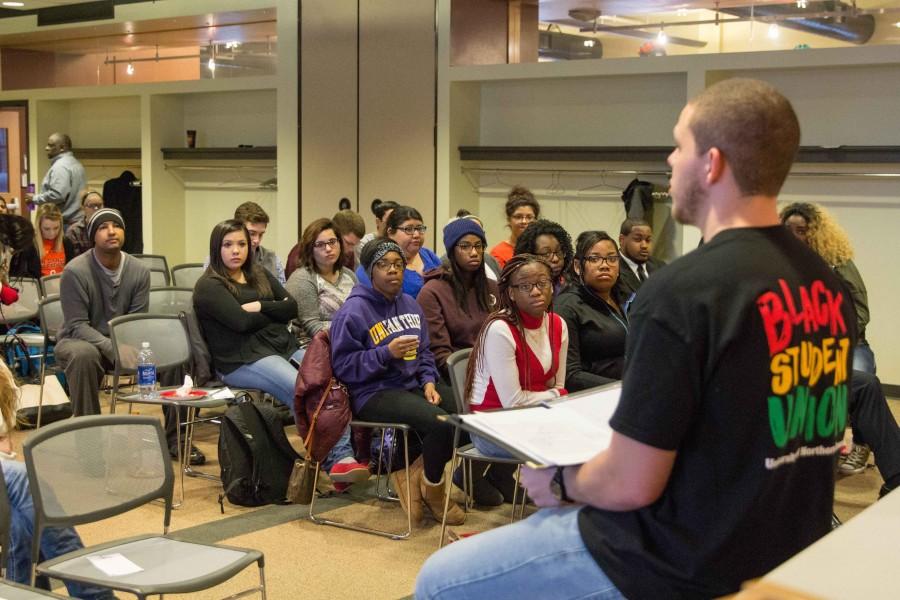Curriculum changes proposed
Hansen Breitling leads an informational meeting updating student about the curriculum change status, among other developments. Some students have expressed interest in there being a new LAC requirement.
Feb 11, 2016
The momentum from last semester’s student diversity forums and talks with administration is moving toward its actualization in the new calendar year said Hansen Breitling, NISG director for diversity and student life.
Breitling, along with NISG vice president, Paul Andersen, and the NISG campus relations committee, is working on a proposal for a curricular exit requirement focusing on issues of diversity, inclusion and social justice.
“The students of UNI deserve this opportunity,” Breitling said. “And [they] will continue to be sorely deprived as long as diversity, inclusion and social justice are not concretely implemented in the list of outcomes the university requires students show competence in [so] that they may obtain a degree.”
UNI’s fellow Regent institutions, the University of Iowa (UI) and Iowa State University, (ISU) have already committed to their own versions of diversity curricular requirements. Most recently, UI has committed to a Liberal Arts diversity requirement for the 2017 school year, according to their now.uiowa.edu website.
ISU currently requires its students to take two courses, one to satisfy the U.S. Diversity requirement and one for the International Perspectives requirement. Students can choose from approximately 170 courses to fulfill the require-ment. Oliverio Covarrubias, junior psychology major, wondered why UNI couldn’t implement an LAC course requirement for diversity. He raised the question during a forum on diversity and discrimination last semester in which stu-dents were able to share their concerns with faculty members and the administration, includ-ing President Bill Ruud and Provost Jim Wohlpart. “It’s more likely that I’m going to run into someone different than me out on the street or in the workplace than I’m going to have to use, say, chemistry in the workplace,” Covarrubias said. According to Brietling, NISG is currently polishing up its official proposal to present to students, faculty and staff for feedback. Breitling said that under the proposal, an exit requirement of, for example, nine or 12 cred-it hours would be implemented. A committee of experts would be convened to judge courses based on learning goals and objectives and would approve or deny a course nominated to be “tagged” as “diversity-inten-sive” with a D tag. Breitling said this tagging system would work much the same as the way certain cours-es are tagged as “writing-in-tensive,” some of which are required to graduate for some majors. He said the official proposal specifies details such as incentives for professors to present their courses and the exact procedure of implement-ing the new exit requirement. “ An exit requirement is ideal because it can provide repeated exposure to teachings on diversity, while allowing for diversity within diversity requirements,” Breitling said. According to Breitling, there are potentially over a hundred courses that could “reasonably” qualify for the D tag — encom-passing many majors, minors, electives and LAC classes.
Covarrubias thinks Breitling’s proposal, applicative across many majors, would be more effective than a single class requirement. He said exposure over the course of a student’s four years at UNI is essential. Stephanie Logan, Chair of the Diversity and Inclusion Council, said she would be supportive of a curriculum requirement because students could benefit from what they have learned years down the road as they enter the work force. She said diversity is a priority in K-12 education already and that should be true of higher education as well. Xavier Escandell, associate professor of sociology and Faculty Senate member, said the Faculty Senate has dis-cussed curricular change deal-ing with diversity and inclusion often, and that the talks revolve around how best to approach the same goal. “Diversity should be a core principle that permeates the institution,” Escandell said. “Not only classes that engage with race and ethnicity are needed, but any class in this institution should think about how they contribute to diversity at UNI.” He said this goes for all “diversities,” including all underrepresented groups, sexualities and those with dis-abilities. There is support for a curricular requirement among multicultural groups at UNI. Alexis Alfaro, Hispanic and Latino Student Union presi-dent, said HLSU supports a curriculum requirement because education is essential to changing the culture at UNI. “We need to have required classes that make everyone aware of diversity issues,” Alfaro said. Some students are a little reluctant to a perceived mandatory enforcement of diversity. “Just in my courses this semester, diversity has come up in every class,” Nancy Snider, junior elementary education major, said. “Professors are interweaving it into my classes. I don’t believe additional classes are necessary.” “If it is made mandatory, there will be so much back-lash from students,” said Kate Anderson, junior public relations major. “I think it should be pushed but not forced. Sadly, you can’t force diversity.” Logan said multiple “diversity-intensive” courses could yield more widespread integration as opposed to a one-and-done type of course. Escandell said it’s UNI’s mission as an institution to communicate the value of engaging with diverse perspectives and underrepresented groups. “If we fail to provide that kind of perspective, we fail as an institution,” Escandell said. Other students are more open to the requirement. “We are seeing a divide going on in our country again,” said Joel Wauters, sophomore political science major. “This [requirement] might help keep it from growing.” “You can say ‘you can’t force diversity,’ but this is the real world. Diversity is going to force itself upon you,” Covarrubias said. “You’re still going to run into people who are different than you … That’s the world we live in, and the world we are going to live in.”
–Megan Johnson, staff writer, contributed to this story









